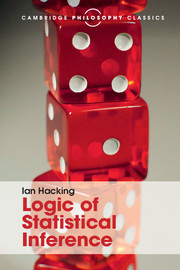Book contents
1 - Long run frequencies
Published online by Cambridge University Press: 05 July 2016
Summary
The problem of the foundation of statistics is to state a set of principles which entail the validity of all correct statistical inference, and which do not imply that any fallacious inference is valid. Much statistical inference is concerned with a special kind of property, and a good deal of the foundations depends upon its definition. Since no current definition is adequate, the next several chapters will present a better one.
Among familiar examples of the crucial property, a coin and tossing device can be so made that, in the long run, the frequency with which the coin falls heads when tossed is about 3/4. Overall, in the long run, the frequency of traffic accidents on foggy nights in a great city is pretty constant. More than 95% of a marksman's shots hit the bull's eye. No one can doubt that these frequencies, fractions, ratios, and proportions indicate physical characteristics of some parts of the world. Road safety programmes and target practice alike assume the frequencies are open to controlled experiment. If there are sceptics who insist that the frequency in the long run with which the coin falls heads is no property of anything, they have this much right on their side: the property has never been clearly defined. It is a serious conceptual problem, to define it.
The property need not be static. It is the key to many dynamic studies. In an epidemic the frequency with which citizens become infected may be a function of the number ill at the time, so that knowledge of this function would help to chart future ravages of the disease. Since the frequency is changing, we must consider frequencies over a fairly short period of time; perhaps it may even be correct to consider instantaneous frequencies but such a paradoxical conception must await further analysis.
First the property needs a name. We might speak of the ratio, proportion, fraction or percentage of heads obtained in coin tossing, but each of these words suggests a ratio within a closed class. It is important to convey the fact that whenever the coin is tossed sufficiently often, the frequency of heads is about 3/4. So we shall say, for the present, that the long run frequency is about 3/4.
- Type
- Chapter
- Information
- Logic of Statistical Inference , pp. 1 - 11Publisher: Cambridge University PressPrint publication year: 2016

